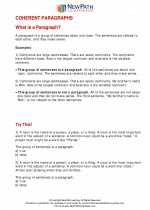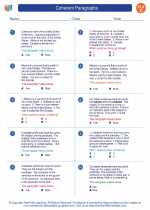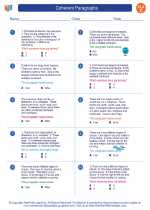Coherent Paragraphs
A coherent paragraph is a group of sentences that are related to one main idea or topic. The sentences within a coherent paragraph should flow logically from one to the next, and the paragraph as a whole should be well-organized and easy to follow.
Characteristics of Coherent Paragraphs
- Unity: Each paragraph should focus on a single main idea or topic.
- Logical Order: The sentences within the paragraph should be arranged in a logical order to support the main idea.
- Transitions: Transitional words and phrases can be used to connect ideas and create a smooth flow between sentences.
- Supporting Details: Relevant supporting details and examples should be included to develop and clarify the main idea.
Study Guide
Here are some tips for creating coherent paragraphs:
- Topic Sentence: Start the paragraph with a topic sentence that introduces the main idea.
- Supporting Details: Include relevant supporting details, examples, and explanations that relate to the main idea.
- Logical Order: Arrange the supporting sentences in a logical order that makes sense and helps to develop the main idea.
- Transitions: Use transitional words and phrases to connect the supporting sentences and create a smooth flow of ideas.
- Concluding Sentence: End the paragraph with a concluding sentence that summarizes the main idea or provides a final thought.
Practice writing coherent paragraphs by selecting a main idea and then organizing supporting details around that main idea. Pay attention to the logical flow of ideas and use transitions to connect the sentences together.
[Coherent Paragraphs] Related Worksheets and Study Guides:
.◂English Language Arts Worksheets and Study Guides Third Grade. Coherent Paragraphs
Study Guide Coherent Paragraphs
Coherent Paragraphs  Worksheet/Answer key
Worksheet/Answer key Coherent Paragraphs
Coherent Paragraphs  Worksheet/Answer key
Worksheet/Answer key Coherent Paragraphs
Coherent Paragraphs  Worksheet/Answer key
Worksheet/Answer key Coherent Paragraphs
Coherent Paragraphs 

 Worksheet/Answer key
Worksheet/Answer key
 Worksheet/Answer key
Worksheet/Answer key
 Worksheet/Answer key
Worksheet/Answer key

The resources above cover the following skills:
Standards for Reading Informational Text (RI)
Craft and Structure
Anchor Standard: Assess how point of view or purpose shapes the content and style of a text.
Distinguish their own point of view from that of the author of a text.
Identify the author’s implied or directly-stated point of view about the topic of the text (e.g., by looking at specific language, punctuation choices, etc.).
Standards for Reading Foundational Skills (RF)
Fluency
Read with sufficient accuracy and fluency to support comprehension.
Read on-level prose and poetry orally with accuracy, appropriate rate, and expression on successive readings.
Use punctuation as cues to appropriate expression.
Standards for Writing (W)
Text Types and Purposes
Anchor Standard: Write arguments to support claims in an analysis of substantive topics or texts, using valid reasoning and relevant and sufficient evidence.
Write opinion pieces on topics or texts, supporting a point of view with reasons – Provide reasons that support the opinion.
Draft the body to support an opinion or point of view through effective organization of reasons (See CCSS W.3.4, W.3.6): Establish the focus of the paragraph/each paragraph with a topic sentence; Organize paragraph(s) effectively (e.g., list, cause/effect, order of importance); Use coordinating and subordinating conjunctions (CCSS L.3.1h); Produce simple, compound, and complex sentences (CCSS L.3.1i); Use commas in addresses (CCSS L.3.2b).
Anchor Standard: Write informative/explanatory texts to examine and convey complex ideas and information clearly and accurately through the effective selection, organization, and analysis of content.
Write informative/explanatory texts to examine a topic and convey ideas and information clearly – Introduce a topic and group related information together; include illustrations when useful to aiding comprehension.
Apply the prewriting stage of the writing process: gather information on a topic (See MD SLM 2-3 2A1, as needed); paraphrase when taking notes from sources; group information by topic or idea; identify, select, and/or create supportive text features, as necessary (See CCSS W.3.4, W.3.5, W.3.6, W.3.7).
Draft an introduction that: orients the reader to the topic; establishes the focus with a topic sentence; presents similar information grouped appropriately (e.g., in one or more paragraphs, as appropriate); includes supportive text features, as necessary; handles copyrighted material appropriately (See CCSS W.3.4, W.3.6; MD SLM 2-3: 3C2).